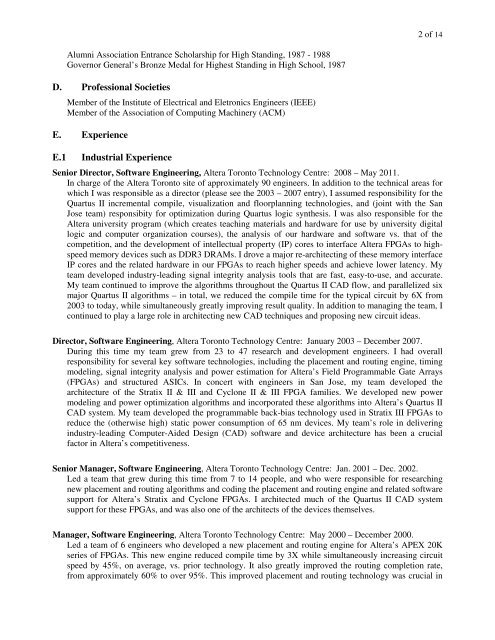My Curriculum Vitae - Computer Engineering Research Group ...
My Curriculum Vitae - Computer Engineering Research Group ...
My Curriculum Vitae - Computer Engineering Research Group ...
You also want an ePaper? Increase the reach of your titles
YUMPU automatically turns print PDFs into web optimized ePapers that Google loves.
Alumni Association Entrance Scholarship for High Standing, 1987 - 1988<br />
Governor General’s Bronze Medal for Highest Standing in High School, 1987<br />
D. Professional Societies<br />
Member of the Institute of Electrical and Eletronics Engineers (IEEE)<br />
Member of the Association of Computing Machinery (ACM)<br />
E. Experience<br />
E.1 Industrial Experience<br />
2 of 14<br />
Senior Director, Software <strong>Engineering</strong>, Altera Toronto Technology Centre: 2008 – May 2011.<br />
In charge of the Altera Toronto site of approximately 90 engineers. In addition to the technical areas for<br />
which I was responsible as a director (please see the 2003 – 2007 entry), I assumed responsibility for the<br />
Quartus II incremental compile, visualization and floorplanning technologies, and (joint with the San<br />
Jose team) responsibity for optimization during Quartus logic synthesis. I was also responsible for the<br />
Altera university program (which creates teaching materials and hardware for use by university digital<br />
logic and computer organization courses), the analysis of our hardware and software vs. that of the<br />
competition, and the development of intellectual property (IP) cores to interface Altera FPGAs to highspeed<br />
memory devices such as DDR3 DRAMs. I drove a major re-architecting of these memory interface<br />
IP cores and the related hardware in our FPGAs to reach higher speeds and achieve lower latency. <strong>My</strong><br />
team developed industry-leading signal integrity analysis tools that are fast, easy-to-use, and accurate.<br />
<strong>My</strong> team continued to improve the algorithms throughout the Quartus II CAD flow, and parallelized six<br />
major Quartus II algorithms – in total, we reduced the compile time for the typical circuit by 6X from<br />
2003 to today, while simultaneously greatly improving result quality. In addition to managing the team, I<br />
continued to play a large role in architecting new CAD techniques and proposing new circuit ideas.<br />
Director, Software <strong>Engineering</strong>, Altera Toronto Technology Centre: January 2003 – December 2007.<br />
During this time my team grew from 23 to 47 research and development engineers. I had overall<br />
responsibility for several key software technologies, including the placement and routing engine, timing<br />
modeling, signal integrity analysis and power estimation for Altera’s Field Programmable Gate Arrays<br />
(FPGAs) and structured ASICs. In concert with engineers in San Jose, my team developed the<br />
architecture of the Stratix II & III and Cyclone II & III FPGA families. We developed new power<br />
modeling and power optimization algorithms and incorporated these algorithms into Altera’s Quartus II<br />
CAD system. <strong>My</strong> team developed the programmable back-bias technology used in Stratix III FPGAs to<br />
reduce the (otherwise high) static power consumption of 65 nm devices. <strong>My</strong> team’s role in delivering<br />
industry-leading <strong>Computer</strong>-Aided Design (CAD) software and device architecture has been a crucial<br />
factor in Altera’s competitiveness.<br />
Senior Manager, Software <strong>Engineering</strong>, Altera Toronto Technology Centre: Jan. 2001 – Dec. 2002.<br />
Led a team that grew during this time from 7 to 14 people, and who were responsible for researching<br />
new placement and routing algorithms and coding the placement and routing engine and related software<br />
support for Altera’s Stratix and Cyclone FPGAs. I architected much of the Quartus II CAD system<br />
support for these FPGAs, and was also one of the architects of the devices themselves.<br />
Manager, Software <strong>Engineering</strong>, Altera Toronto Technology Centre: May 2000 – December 2000.<br />
Led a team of 6 engineers who developed a new placement and routing engine for Altera’s APEX 20K<br />
series of FPGAs. This new engine reduced compile time by 3X while simultaneously increasing circuit<br />
speed by 45%, on average, vs. prior technology. It also greatly improved the routing completion rate,<br />
from approximately 60% to over 95%. This improved placement and routing technology was crucial in














